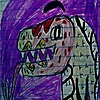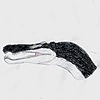HOME | DD
 Sheather888 — The Scarreots
Sheather888 — The Scarreots

#serina #speculativeevolution
Published: 2023-12-02 23:41:57 +0000 UTC; Views: 23221; Favourites: 408; Downloads: 0
Redirect to original
Description
Skewers in the late hothouse have diversified across many habitats, diets, and sizes. A diverse clade called the flickbills, which includes the fierce rendrunner, sinister daggerbill, and tiny taptrackers, is among the most varied. These skewers provide the greatest degree of parental care to their larval young, often creating and protecting nests for them in the form of tree hollows or, in open habitats, clay chambers in which they provide food to the larvae until they pupate and fledge.
Most species of skewer seen so far in the hothouse, of this clade and others, have all remained mostly carnivorous. Indeed, the vicious spiked beak of the clade, from which they are named, evolved as a deadly offensive weapon that let their pollinating ancestors become deadly predators. But some late hothouse skewers have evolved down different lines again, using this structure to process different types of food. The flexing, jointed mandible is as close to a new, proper limb as any contemporary bird has evolved (trunko limbs have no bones) - and its uses are varied. Some forest skewers learned to use it to help climb, as a hook to hold branches, and this occasionally brought them into contact with novel food sources like fruit and seed. The beak, by folding backward against itself, could easily break open these things into a soft pulp that could be licked up by the tongue, and some skewers became omnivorous in this way. These birds were the ancestors of a very young yet extraordinarily widespread and specious group of late hothouse birds called scarreots, which are remarkable for now using their once deadly beaks to crack nuts and seeds, and for their diurnal nature and vibrant color in contrast to most of their relatives.
There are hundreds of species of scarreots, all of which arose within the last ten million years. The most primitive species are relatively large forest-dwellers, and have some resemblance to the related daggerbills. These species are fairly slow-moving and climb much more than they fly, travelling through high branches to collect fruit and large seeds which they smash by closing their robust upper beak's two parts together like a nutcracker; the largest member of this group is flightless, and has specialized its diet to be comprised mostly of vegetation. More divergent forms have arisen however - some which are smaller and stronger flyers, an interesting form of neoteny in which they have more or less stalled their development at a more adolescent life stage similar to the juveniles of their larger relatives, and so remained nimble flyers through adulthood. Many of these species are known as scareakeets, though this is not a taxonomic distinction and purely a classification based on general size. Scareakeets include several only distantly related lineages of scarreots which have evolved similar body shapes with long tails and pointed wings for flying long distances. While many still forage in trees and breed in forests, some have moved into open savannah habitats and feed mainly on the ground, collecting the fallen seeds of grassland plants. In addition, other scarreots have branched off into more divergent niches. Psittacansers are adapted to feed on shelled molluscs rather than seeds, and so are usually associated with water. They include both duck-like swimmers and wading species very distinct from all other scarreot clades.
Descriptions of every species can be read on the sites page here: sites.google.com/site/worldofs…
Consider supporting Serina on Patreon. There are many dozens of currently exclusive posts which are still months from being published! www.patreon.com/sheatherius
Related content
Comments: 33

👍: 1 ⏩: 0

👍: 0 ⏩: 0

👍: 1 ⏩: 0

👍: 1 ⏩: 0

👍: 5 ⏩: 1

👍: 1 ⏩: 0

👍: 3 ⏩: 2

👍: 3 ⏩: 0

👍: 0 ⏩: 1

👍: 1 ⏩: 1

👍: 0 ⏩: 2

👍: 0 ⏩: 0

👍: 1 ⏩: 2

👍: 4 ⏩: 0

👍: 0 ⏩: 0

👍: 1 ⏩: 0

👍: 0 ⏩: 2

👍: 5 ⏩: 0

👍: 5 ⏩: 0

👍: 0 ⏩: 0

👍: 3 ⏩: 0

👍: 1 ⏩: 0

👍: 2 ⏩: 0

👍: 1 ⏩: 0

👍: 0 ⏩: 1

👍: 6 ⏩: 2

👍: 1 ⏩: 0

👍: 1 ⏩: 0

👍: 7 ⏩: 0

👍: 6 ⏩: 0

👍: 1 ⏩: 0

👍: 0 ⏩: 0


















